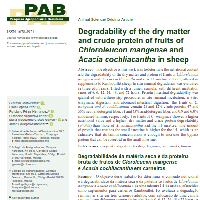Resumen
-
O objetivo deste trabalho foi determinar o conteúdo nutricional e a degradabilidade da matéria seca e da proteína de frutos de Cloroleucon mangense e Acacia cochliacantha e de uma mistura 1:1 de ambos, oferecidos como suplementos para carneiros Rambouillet. Foi avaliada a degradação ruminal in situ em três carneiros adultos, com colocação de uma cânula ruminal, com diferentes tempos de incubação de 0, 6, 12, 24, 48 e 72 horas. A degradação intestinal da proteína foi quantificada por meio de procedimento com três etapas: incubação ruminal in situ, digestão enzimática in vitro e digestão abomasal intestinal. Os frutos de C. mangense e A. cochliacantha contêm 21% e 12% de proteína bruta, 47% e 56% de fibra em detergente neutro, 31 e 43% de fibra em detergente ácido e 0,9 e 6,0% de taninos condensados, respectivamente. Os frutos de C. mangense apresentaram valor nutricional edegradabilidade da matéria seca e da proteína bruta (p<0,05) maiores que os de A. cochliacantha e da mistura 1:1. A quantidade de proteína que chega ao intestino delgado é maior para a mistura 1:1, o que é indicativo de que sua concentração de tanino é suficiente para aumentar a proteína não degradável no rúmen absorvida no intestino delgado.
-
The objective of this work was to determine the nutritional content and the degradability of the dry matter and protein of fruits of Chloroleucon mangense and Acacia cochliacantha and of a 1:1 mixture of both, offered as supplements to Rambouillet sheep. In situ ruminal degradation was evaluated in three adult rams, fitted with a rumen cannula, with different incubation times of 0, 6, 12, 24, 48, and 72 hours. Protein intestinal degradability was quantified with a three-step procedure: in situ ruminal incubation, in vitro enzymatic digestion, and abomasal-intestinal digestion. The fruits of C. mangense and A. cochliacantha contain 21 and 12% crude protein, 47 and 56% neutral detergent fiber, 31 and 43% acid detergent fiber, and 0.9 and 6.0% condensed tannins, respectively. The fruits of C. mangense showed a higher nutritional value and a higher dry matter and crude protein degradability (p<0.05) than those of A. cochliacantha and the 1:1 mixture. The amount of protein that reaches the small intestine is higher for the 1:1, which is an indicative that its tannin concentration is enough to increase the bypass protein that can be absorbed in the small intestine.
